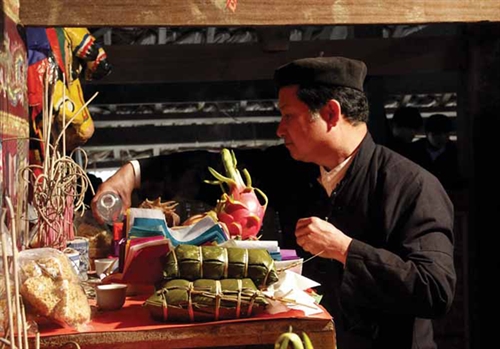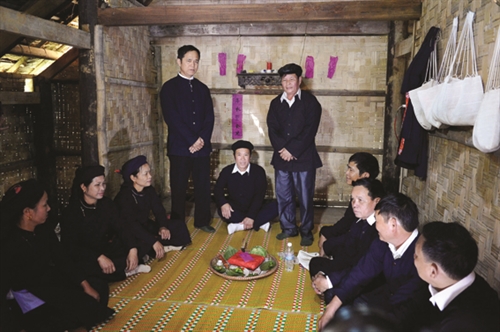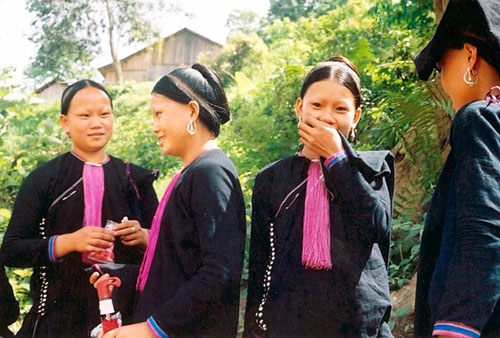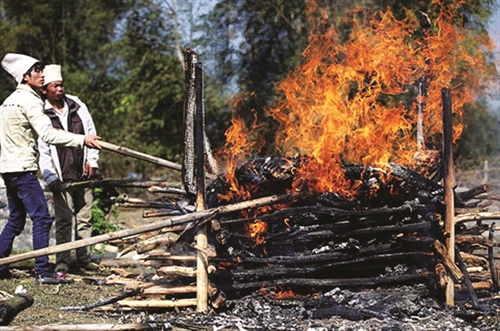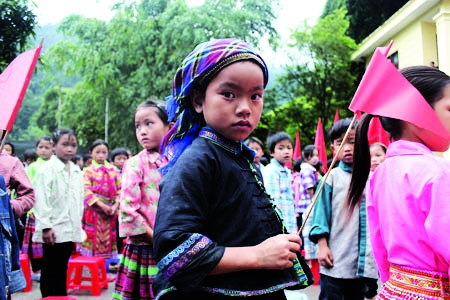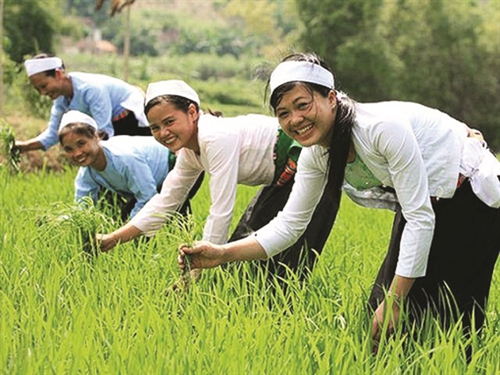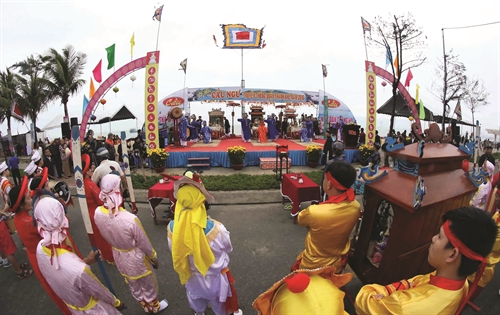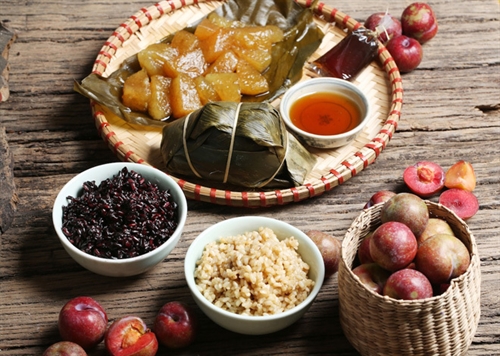>>Mourning rituals of the Nung Din
>>Nung ceremony upholds a child’s learning
Phan Thi Ngoc
Ethnology Museum
Veneration of pay tho (God of Land) is very important for the Nung, the 7th largest ethnic group in Vietnam with a population of over one million.
Pay tho is believed to be the god who looks after the land of a Nung village, bringing peace and prosperity for all villagers living on that land.
Every Nung village has a shrine for worshiping pay tho, which is built as soon as the village is set up. The site for building the shrine, which is carefully selected by the village geomancer, must be an airy and quiet place located at either end of the village.
The shrine is built simply with a wood framework and a corrugated iron roof as the Nung believe the simpler the shrine is, the more sacred it is. Pay tho shrine is the place for all spiritual community gatherings which help strengthen unity and attachment among villagers. The shrine is also where individual families pay tribute to pay tho when they have a family event such as building a new home or having a newborn or a member who passes away.
The Nung venerate pay tho in all farming rituals in a year, the first and most important of which is the Lunar New Year festival. On the second day of the new year, every Nung village holds an offering ritual at pay tho shrine. In this ceremony, each family line in the village prepares a tray of offerings which include a boiled capon, a pair of banh chung (boiled square sticky rice cake filled with greenbean paste and pork and wrapped in banana leaves), banh khao (sweet patty made of mashed rice), white sticky rice, cookies, candies and liquor. A clan which has the most beautiful and largest boiled capon is believed to enjoy a year of prosperity. That’s why, the ritual is unspokenly a contest for family lines to show their wealth through their offering trays. The offering ritual is officiated by a village patriarch or a shaman who prays for pay tho’s support for peace, prosperity and happiness for all villagers. Representatives of clans then make offerings to pay tho one after another. Completing the ritual, the officiating person pours liquor onto the incense holder and around the shrine. After that, villagers share the offerings, cheering for a new year of best luck. On the way home from the shrine, villagers throw sticky rice to feed chickens and pigs in hopes of gaining a year of growing herds of cattle and flocks of poultry.
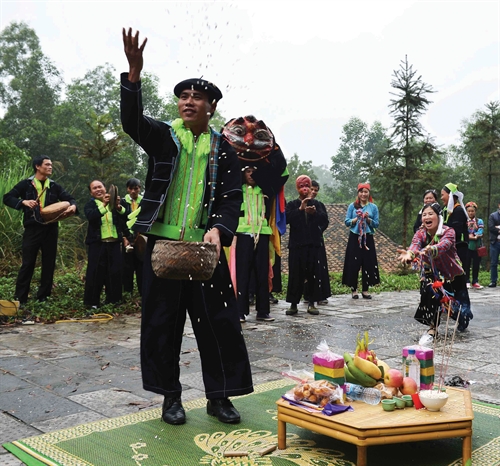 |
| Offering ritual in the Nung’s festival for the god of agriculture’s support for bountiful crops (Lang Son province)__Photo: Thanh Ha/VNA |
The lunar new year ceremony is followed by sinh minh festival which falls on the 3rd of the third lunar month, the time to start the winter-spring crop. In this festival, Nung people pay tribute to pay tho for the god’s blessing for a verdant crop. Typical offerings of this ceremony include a boiled duck and dishes made from rice such as vermicelli, banh te (boiled rice cake filled with pork and Jew’s ear) and votive papers. In this ceremony, the ritual conductor, who is either the village shaman or patriarch, recites prayers which praise pay tho’s merit for protecting the village, invite him to have deferentially prepared offerings and ask for his support for a year of favorable weather and bumper crops.
Next is so looc ceremony which is held on the 6th of the sixth lunar month to pray for pay tho’s protection of the crop from pests which grow rampantly in mid summer. The offerings are the same as for sinh minh. After the shaman completes the praying formality in which he thanks pay tho for his blessing and asks the god to guard the crop from thieves and harmful pests, votive papers are burnt and the offerings are eaten by representatives of families in the village.
Then comes the Nung’s second largest festival - slip sli, which lasts from the 13th through the 15th of the seventh lunar month. At this time, the Nung, having just finished transplanting the summer-autumn rice seedlings, clean up pay tho shrine and hold a thanksgiving ritual to the god. Offerings include pork, vermicelli and banh gai (sesame-sprinkled cake, made of glutinous rice blackened in edible leaves and green bean, coconut shred and sugar-coated lotus seed stuffings and wrapped in dry banana leaves).
Finally is phung toong (new rice festival) celebrated in the tenth lunar month after the harvesting time to show the Nung’s gratitude toward the rice god for bestowing them verdant crops. One of the formalities of this ceremony is paying tribute to pay tho where Nung people sacrifice a pig and make banh day (round sticky rice cake) as offerings to the god.
Pay tho is also revered in long tong (going down the field) festival, a religious farming ceremony of the Nung, which is dedicated to the god of agriculture to win his support for bountiful crops and prosperity for villagers throughout the year.
Held in a large harvested field in the middle of the village, the festival consists of three main parts: offering ritual which includes a water procession, plowing rite and folk games.
In this festival, every family in the village prepares an offering tray, which usually contains a boiled young hen or rooster, a plate of boiled pork, a bowl of red sticky rice and a bowl of yellow sticky rice. Village dignitaries also prepare two trays with offerings double in quantity together with a pair of banh chung and two bowls of banh troi (round sticky rice dumplings with brown sugar filling). These special offering trays are placed near the shaman’s, which is placed on a square rattan tray in the center of the altar. The shaman’s offering tray contains a bowl of holy water with a silver coin at the bottom, a boiled chicken, some grilled fish, a bowl of chicken blood, a sharp knife, a roll of newly weaved cloth and two red-paper carps. In the middle of the tray are placed two bunches of flowers made of puffed sticky rice stuck to a banana stem.
The offering ritual is conducted by the village shaman right in the rice field where a bamboo altar is set up. In this ritual, the shaman invites gods and goddesses, including pay tho, to the rite and calling for their support for the village to have bumper crops and be free from diseases and misfortunes.
The offering ritual is followed by a plowing ceremony in which the head of the festival leads a carefully selected male buffalo to make the first furrows of the year. Villagers are believed to get good luck and yield bumper crops throughout the year if this buffalo makes straight furrows. After the plowing ceremony, villagers eat the offerings together. The offering tray prepared by the village is offered to village dignitaries and old villagers. Friends from other villages may be also invited to join the party.
Then comes the most exciting part of the festival, folk games, central to which is nem con (throwing con through the ring on the top of a bamboo pole). Con is a small ball made from pieces of colorful cloths sewn together, stuffed with puffed rice and cotton seeds and decorated with gaudy cloth tassels.
To kick off the game, the shaman prays in front of the con pole and then throws the con on the offering tray to young people surrounding him. The person who first catches the con will throw it through the ring. If he succeeds, he will receive a prize of three meters of cloth. The shaman will rip the successfully thrown con to take out the puffed rice inside, mix them with a basket of dried paddies and throw them to festival goers who will use their shirt flaps to catch these paddies as many as possible since this act is believed to bring them prosperity and success throughout the year.
Other games in the festival include tug of war, yen playing (a game similar to badminton, but played between a man and a woman) and fencing played by six men carrying bamboo swords and six women with shields made of areca spathe who dance to the sound of drum beats.-

